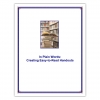Write for Your Healthcare Audience
As you develop written healthcare materials for patients, you need to think about vocabulary and sentence structure, organization of ideas, as well as layout and design elements so that you can eliminate as many unnecessary barriers as possible.
One resource from Harvard School of Public Health, Assessing and Developing Health Materials, explores the components of reading:
- Alphabetics—the process of using letters in an alphabet to represent sounds in the spoken word
- Fluency—ability to read with speed and ease
- Vocabulary—knowledge of the meaning of a word
- Reading comprehension—a language construction process
It also differentiates between beginning, intermediate and advanced readers:
- Beginning—developing skills in sounding out words
- Intermediate—building background knowledge and vocabulary
- Advanced—reading with speed and ease
Use the assessment tools, guidelines and sample materials provided to determine the readability of your writing.
Health literacy is a vital component of reducing hospital readmissions and adverse drug events. Go here to see how atom Alliance works with providers to improve care coordination and how you can get involved.

Preview: Rapid Estimate of Adult Literacy in Medicine - Short Form (REALM-SF)
Download
25.28 KB | Last Updated: February 6, 2015

Preview: Short Assessment of Health Literacy for Spanish Adults (SAHLSA-50)
Download
131.77 KB | Last Updated: February 6, 2015



